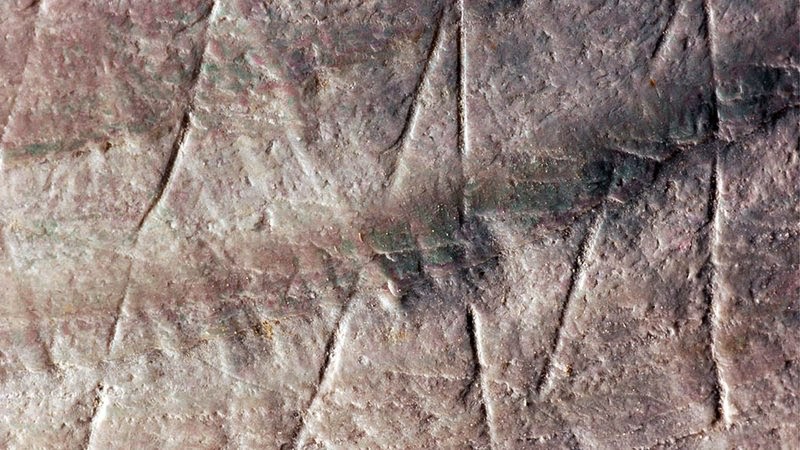Saturday, February 28, 2015
THE EARLIEST ART – HOMO ERECTUS ENGRAVED SHELL:
Mussel shell with scratch markings made by Homo erectus,
Trinil Site, Solo River, Java, Indonesia. Photograph Wim
Lustenhouwer, VU University Amsterdam.
No matter what your particular interest is in the field of
rock art you cannot avoid questions about the art produced by early cultures.
Much has been published about the cave art of Cro Magnon peoples in Europe.
Even before Cro Magnon there are items from Neanderthal contexts that show the
beginnings of artistic sensibility. Now that horizon has apparently been pushed
back almost a half millennia. On December 4, 2014, Nature published an article
on a decorated shell recovered from Homo erectus material in Java, Indonesia,
and this was mirrored by a publication on the same discovery in
Smithsonian.com.
The shell is one that had been recovered along with fossil
bones by the 19th-century Dutch physician Eugene Dubois, along the
Solo River on the island of Java. Dubois named his discovery Java Man but it is
now known as Homo erectus.
“Dubois collected 11
species of freshwater shells at the site, called Trinil. Most of them belong to
the sub-species Pseudodon vondembuschianus trinilensis, a now extinct
freshwater mussel he described in 1908.” (Thompson) The excavated shells represented at least 166
individual Pseudodon mussels, but scientists initially were unsure that they had
any connection to Homo erectus.
Now a new study of those shells at Naturalis Biodiversity
Center, in Leiden, Netherlands, under the lead of Josephine Joordens from
Leiden University has discovered that a number of the shells had been modified
by Homo erectus.
Slash marks on mussel shell. Photograph Wim
Lustenhouwer, VU
University Amsterdam.
Archaeologist Stephen Munro, working with Joordens, first
noticed the lines engraved into the one shell. The lines appear as a series of
slash marks with four of them assembled into a shape like the capital letter
“M.” On this carved shell the lines had originally been deeply engraved into
the calcium carbonate shell. This enabled the carving to survive for so long. “The shell with the engraving, was likely
carved with a sharp object, such as a shark tooth. At the time of its carving,
the shell likely had a dark covering, and the marks would have appeared as
white lines, Joordens said.” (Geggel) Researchers hypothesizing that the
engraving on the shell had also have been done by a Homo erectus wielding a
shark’s tooth to scratch the lines, tested this with a modern mussel shell and
used sharks teeth to make marks on it.
“The researchers used
two dating techniques on preserved sediment in the shells to determine their
age: between 540,000 and 430,000 years. They team also used x-rays to examine
the Homo erectus bones and confirm that they came from the same rock layer as
the shells. The results suggest that the Homo erectus fossils on Java aren’t
quite as old as we thought they were.” (Thompson)
One
of the shells has a smooth and polished edge, suggesting it may have been used
as a tool for cutting or scraping. “We
found at least one that was very clearly and deliberately modified so that a
sharp edge was produced that could be used like a knife,” Joordens said. ”There
are other shells in the collection that have this tool-like appearance.” (Geggel)
Pierced mussel shell, presumable by opening it
for food. Photograph Henk Caspers, Naturalis.
“Additionally, a large
percentage of the shells were pierced in a certain location. “About one-third
of the shells have a small hole that does not appear to be made by an animal,
such as an otter, rat, bird, monkey, or snail. About 80 percent of the holes
are made in the same location – near the shell’s hinges, and measure about 0.2
to 0.4 inches (0.5 to 1 centimeter) across.
It’s a clever way to
get a snack, “without smashing the shell, so that you have all kinds of debris
and breakage in the meat of the animal.” Joordens said. Perhaps Homo erectus
pierced the shells with sharp points, such as the shark teeth that were found
at Trinil, the archaeological site in Java, Joordens said.” (Geggel) Modern experimentation has shown that once a
mussel is pierced there the animal loses strength in it muscle and the shell
can be easily opened. This also indicated to the researchers that the mussels
were eaten raw as the shell of a cooked mussel opens naturally by itself,
suggesting that the Trinil site on the Solo River on the island of Java served
as sort of an oyster bar for Homo erectus. But whatever their actual activities
and purposes there, one of them, on one occasion, used a hard, sharp point to
engrave lines into a mussel shell. A shell that survived until excavated by Eugene
Dubois in 1891 and 1892, and then sat on a shelf until recently examined by
Stephen Munro. What an amazing day for Munro - and for us.
REFERENCES:
Geggel, Laura
2014 540,000-Year-Old Shell Carvings May Be Human
Ancestor’s Oldest Art, on December 3, LiveScience.com
Thompson, Helen
2014 Zigzags on a Shell From Java Are the Oldest
Human Engravings, on December 3, Smithsonian.com.
Subscribe to:
Post Comments (Atom)








No comments:
Post a Comment